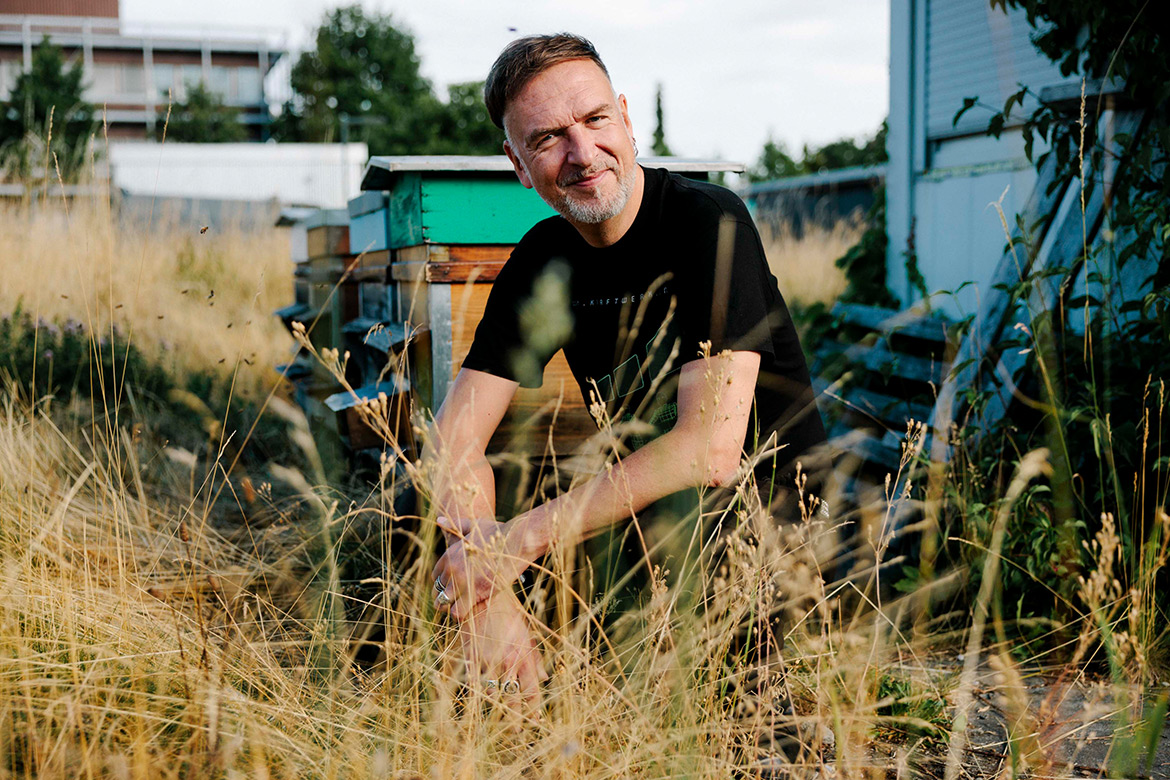PORTRAIT
Dances with bees
Peter Neumann is Switzerland’s first professor in honeybees. He tells us why he’s committed to preserving these endangered insects across the world, and how he fell in love with a bee colony in Brazil. His profession used just to make people smile, but today it’s highly respected.

Today, the honeybee professor Peter Neumann no longer looks like a zombie after being out with the bees. You can only see dots, he says. | Photo: Fabian Hugo
“The bees relieved me of dreadful pain!” Peter Neumann is sitting on the carpet in front of his motel bed. His curtains are drawn, his suitcases still packed. It’s not worth unpacking them, because Switzerland’s first honeybee professor is buzzing straight off on a research trip. Yesterday he was still in Bern, today he’s in Maryland in the USA, tomorrow he’ll be in the state of Georgia, then he’ll be off to Alabama, Mississippi, and from there his journey will take him round the globe to Thailand. As busy as a bee, you might think. “Actually, bees are lazy! They sleep a lot. They’re just better organised than I am”. He laughs out loud.
Neumann’s on a video call with us, chatting vividly about his past journeys: “In the African thornbush savannah of the Kalahari, I was once observing a bee colony when a tooth filling fell out and the gap got infected. The village doctor wanted to use a drill on me without anaesthetic”. That’s when Neumann fled back to the bees, he says. He used a chisel to break out some propolis from the hive – that’s the tree resin the bees process to use as cement. He made a ball with it and stuffed it into the hole in his tooth. After just one night, he says, the pain subsided. That’s because the substance is anti-inflammatory – just like honey. “I’m no brave hero!”. He laughs out loud again.
But he’s not that sensitive to pain either. As a bee expert, he’s been stung thousands of times. He’s over two metres tall – much taller than the average man – so the sleeves and trouser legs of his beekeeping suits are often too short and have to be sealed with gaffer tape, especially on the African continent where the bees are more aggressive. “But a few of them always manage to get under the fabric all the same to sting you”. Afterwards, he can have up to thirty stings across his face, wrists and ankles that look like little air cushions. “It’s part of the job”, he says. At some point, however, the body gets used to the poison. “These days, I no longer look like a zombie after being out with the bees. You only see dots on me”. Even when he was a kid back in Berlin, Peter Neumann loved spending time with insects. He’d lie on the asphalt, feeding ants ice cream and observing how these socially minded little animals helped each other. He would try counting how many bees were in a swarm, and was fascinated by how wasps would hack out little pieces of ham at breakfast. He wanted to understand how such seemingly stupid animals manage to organise themselves so cleverly – and how they ultimately manage to make the right decisions together. The bees might have done Neumann a good turn in the Kalahari, but it’s actually their health to which he is devoted. As head of the Institute for Bee Health at the University of Bern and as the president of COLOSS, a research network of some 1,900 bee experts from 114 countries, he is researching into the causes of bee mortality across the world. Over the course of his mission, Neumann has worked and lived with bees all over the globe – the only exceptions being the Arctic regions, where bees are absent. “Polar bears and honeybees have something in common, though”, he says. “They’re cute. People get a bit worried when they starve”. Thirty years ago, people used to laugh at his research. They didn’t understand how he could possibly earn a living from something so absurd as the health of bees. But that’s all changed. Small wonder: the bees are in worse shape than ever before – in fact, the same applies to insects in general. What’s more, we need them. Of course, measuring the value of other living creatures according to the benefits they bring us is madness. “But we have to be aware that insects are important for us and that we ought to be protecting them”. There’s a famous quotation that is often attributed to Einstein, but was probably invented by beekeepers: “Once the bee disappears from the Earth, man will only have four years to live”. It’s not as simple as that, but it’s true that pollinators are crucial if we are to have a cheap, healthy diet. According to Neumann, about one third of our food depends on them. “There’s crystal-clear data proving that colony losses are too high. A 10 percent loss each year is normal for beekeepers in Switzerland. But 20 to 30 percent isn’t. I even know many cases where all the bees have died off”. Almost all the honeybees kept in this country are chronically ill – they’re infested with the virus-ridden varroa mite. We can treat them with medication to a certain extent. But most colonies on earth are in the wild – some 90 percent of them. “That’s where I see the bigger problem, because we have no control over them. Many bee species are threatened with extinction. In the history of life on Earth, there’ve been repeated extinctions of fauna in which about 90 percent of species have disappeared. But insects have always been exempt. They’re tough. Now, for the first-ever time, they’re dying out en masse. And we don’t know the reasons for it. It’s scary”. There are a few main suspects, though. There are adventive pests like the varroa mite, dwindling habitats, pesticides and climate change. One of Neumann’s specialities is the small hive beetle. It’s native to sub-Saharan Africa, but global trade took it to other continents. It’s a parasite that feeds on honey, pollen and bee brood, and even manages to get honeybees to feed it directly. Neumann’s travels across the USA are intended in part to help him investigate the beetle. He’s involved in a project to ascertain the extent to which invasive insect species adapt their mating and reproduction when they spread to a new habitat. “Adventive species are a major problem. They can cause massive damage and multiply phenomenally”. Initial results have clearly shown that the females and males of the beetle generally mate multiple times, which could help to explain how they are so successful in becoming established in new areas. But there are also reasons for hope. Neumann has been able to show that viruses from bees kept by humans are less harmful to wild bees than was previously assumed. What’s more, he says, bees in Brazil and Africa are robust and can cope with both the varroa mite and bad beekeepers. “In Brazil, I fell in love with a healthy bee colony that’s like in a picture book. If we can understand them, we’ll have gained a lot”. He reads colonies analytically from front to back, like a book. What’s happening at the entrance to the hive? Is there bee brood? Are there holes in the nest? Just like bees in a field of wildflowers, Neumann now zips from one fact to another until your head is buzzing. Bees take turns keeping each other warm. Bees have talents and preferences. Bees communicate through scent, dancing and feeler-tapping. Bees can count. Bees understand zero. Sometimes, when he gets really passionate, he waves his hands to help tell his story. “Yes, I live at high speed”, he says. Of course, he adds, he can’t act like that out in the field. “But the bees make me calm. That’s when I can slow down and say ‘oooommm’. Others light incense candles. What does it for me is the bee smoker”. As cute as a polar bear
Scary mass mortality




